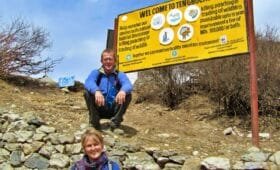The Jiri to Everest Base Camp Trek is the original, time-honored approach to Nepal’s iconic Everest region. Before the Lukla airstrip existed, legendary mountaineers like Sir Edmund Hillary and Tenzing Norgay Sherpa began their expeditions from Jiri—a modest Dolakha District town about 190 kilometers east of Kathmandu. You recapture that old-school spirit by choosing the Jiri to Everest Base Camp Trek. You experience longer days, deeper cultural immersion, and thorough acclimatization, culminating in the ultimate reward: seeing Everest up close at Base Camp (5,364m).
This comprehensive Jiri to Everest Base Camp guide explores every facet of the Trek, from daily itineraries and cost breakdowns to difficulties, best seasons, and philanthropic synergy with Volunteers Initiative Nepal (ViN). Suppose your dream is to follow the footprints of mountaineering pioneers and traverse scenic mid-hills before ascending the Everest corridor. In that case, the Jiri to Everest Base Camp Trek brings you a journey of old-world charm and modern wonders.
Introduction
1. Introduction: Why the Jiri to Everest Base Camp Trek?
While most trekkers take a short flight to Lukla, the route from Jiri offers a rewarding, multi-day preamble through lesser-known villages and passes. The early segments meander across farmland, deep valleys, and lively towns like Shivalaya, Sete, and Junbesi, revealing unique local culture glimpses. As you ascend daily, your body gains crucial acclimatization advantages—helping you cope more smoothly once you approach higher altitudes near Namche, Tengboche, and EBC.
Statistic: The Nepal Tourism Board estimates that only ~10% of Everest-bound trekkers attempt the Jiri to Everest Base Camp Trek, overshadowed by Lukla’s convenience. Yet those who do discover an authentic sense of progressive altitude gain, quieter trails, and intense cultural engagement.
“I chose the Jiri to Everest Base Camp Trek to retrace the footsteps of early Everest expeditions. The journey’s scenic farmland and daily passes built up my fitness, making the final approach to Base Camp more comfortable,”
says Alicia, a 34-year-old trekker from Canada.
Overview
2. Cultural & Geographic Overview
2.1 Jiri: The Classic Gateway
Perched at ~1,955 meters, Jiri is historically called the “Switzerland of Nepal” for its rolling green hills and mild climate. This charming rural hub was once the primary route for Everest expeditions. Despite modernization and roads, Jiri has retained a local charm, with markets offering produce, dairies, and simpler teahouses.
2.2 The Lower Solu-Khumbu Region
The initial days of the Jiri to Everest Base Camp Trek traverse the Solu region, home to diverse ethnic groups: Brahmin, Chhetri, Rai, Tamang, and some Sherpa. Before reaching higher Sherpa enclaves in the Khumbu region near Namche, you’ll ascend passes like Deurali (~2,700m) and Lamjura La (~3,530m). Expect farmland, forests, and an array of micro-climates, culminating in the sub-alpine landscapes that characterize the Everest corridor.
2.3 Transition to Everest Corridor
After crossing the mid-hills, the route merges with the Lukla trail near Chheplung or Kharikhola or after crossing the Taksindu La (~3,070m). By arriving at Namche Bazaar (~3,440m), you’re well acclimatized, with a robust foundation for tackling the final ascent to Everest Base Camp.
Trek Itinerary
3. Jiri to Everest Base Camp Trek Itinerary
A standard Jiri to Everest Base Camp Trek Itinerary spans ~20–22 days from Kathmandu, assuming a day for bus travel to Jiri plus 16–19 trekking days, plus a buffer or rest. Below is a representative 20-day plan:
Day 1: Drive Kathmandu → Jiri (~1,955m)
~7–8 hour bus ride. Overnight in a modest teahouse at Jiri.
Day 2: Jiri → Shivalaya (~1,790m)
~5–6 hours. Gentle farmland, crossing small passes.
Day 3: Shivalaya → Deurali (~2,700m) → Sete (~2,575m)
~7–8 hours. Climb Deurali pass and descend to Sete.
Day 4: Sete → Lamjura La (~3,530m) → Junbesi (~2,700m)
~6–7 hours. Lamjura La is the trek’s highest-pass, scenic rhododendron forests.
Day 5: Junbesi → Nunthala (~2,200m)
~6–7 hours. Pass local monasteries and farmland, crossing the Dudh Koshi at certain points.
Day 6: Nunthala → Kharikhola (~2,010m)
~5–6 hours. Some descents, followed by moderate climbs.
Day 7: Kharikhola → Paiya / Chheplung (~2,730m)
~6 hours. Merging gradually with the Lukla route.
Day 8: Paiya → Phakding (~2,610m)
~5 hours. Now, on the main Everest corridor.
Day 9: Phakding → Namche Bazaar (~3,440m)
~5–6 hours. Cross multiple suspension bridges over Dudh Koshi.
Day 10: Acclimatization in Namche
Explore local markets, vantage points, or day-hike to Everest View Hotel (~3,880m).
Day 11: Namche → Tengboche (~3,867m)
~5–6 hours. Panoramic glimpses of Ama Dablam, Everest.
Day 12: Tengboche → Dingboche (~4,410m)
~5–6 hours. A gradual climb across the Imja Khola.
Day 13: Acclimatization in Dingboche
Day-hike to Nangkartshang (~5,083m) or explore local farmland.
Day 14: Dingboche → Lobuche (~4,910m)
~5 hours. Memorial site for fallen climbers near Thukla Pass.
Day 15: Lobuche → Gorak Shep (~5,164m) → EBC (~5,364m) → Back to Gorak Shep
~7–8 hours. Achieve Everest Base Camp, your ultimate goal.
Day 16: Gorak Shep → Kala Patthar (~5,545m) → Pheriche (~4,371m)
Sunrise vantage at Kala Patthar for Everest close-ups, descending ~7–8 hours.
Day 17: Pheriche → Namche (~3,440m)
~6–7 hours. Mostly downhill, but short ascents occur.
Day 18: Namche → Lukla (~2,840m)
~6–7 hours. Final day of trekking.
Day 19: Fly Lukla → Kathmandu
Morning flight ~30 minutes.
Day 20: Buffer/Leisure Day in Kathmandu
For flight disruptions or exploration in Kathmandu.
The Jiri to Everest Base Camp Trek Duration can stretch from 18 to 24 days, depending on rest days, side expansions, or continuing to Gokyo or side valleys.
Trek Distance
4. The Jiri to Everest Base Camp Trek Distance
Trek Distance is ~185–190 km. The Jiri–Lukla portion is ~70–75 km, and the Lukla–EBC portion is ~110–115 km round trip. Daily segments range ~12–20 km, typically 6–8 hours’ walk. The route’s significant advantage is progressive altitude gain. When you reach Lukla or Namche, your body is already partially acclimatized, easing the final push to Base Camp.
Trek Difficulty
5. Evaluating Jiri to Everest Base Camp Trek Difficulty
Trek Difficulty is advanced moderate:
- Length & Duration: ~18–22 days, requiring consistent stamina.
- Altitude: Topping out at 5,364m at EBC or 5,545m at Kala Patthar.
- Daily Gains: The Jiri portion repeatedly crosses passes like Lamjura La (~3,530m). There is more total up-and-down than on Lukla-based itineraries.
- Isolation: Fewer teahouses in the early segments can add logistical complexity.
While physically demanding, the Jiri approach fosters superior acclimatization once in the Khumbu region, reducing the risk of altitude sickness. With methodical pacing, novices with moderate fitness can successfully complete the trek.
Trek Cost
6. Budgeting: Jiri to Everest Base Camp Trek Cost
Jiri to Everest Base Camp Trek Cost typically surpasses Lukla-based routes due to extra days, lodging, and food. Key budget elements:
Transport
Bus from Kathmandu to Jiri: ~USD 10–15 or private jeep (~USD 150–200 if shared).
After the trek, the flight from Lukla to Kathmandu is ~USD 180–200.
Food & Lodging
Basic teahouse rooms: ~USD 3–5 at lower altitudes, ~USD 5–8 near EBC.
Meal costs: ~USD 20–30 daily, rising to ~USD 35 near Gorak Shep or EBC.
Permits
Sagarmatha National Park (~USD 30), local municipality fees (~USD 20), plus TIMS (~USD 10–20).
There is no special restricted permit for the standard route.
Guide & Porters
If hiring a Trek Guide: ~USD 25–30/day. Porters ~USD 15–20/day.
Misc
Hot showers (~USD 2–5), Wi-Fi or charging (~USD 2–5). Additional expansions or rest days add daily lodging and food costs.
Hence, for ~20 days, a minimal approach might cost ~USD 800–1,200 plus a flight from Lukla. A Jiri to Everest Base Camp Trek Package arranged by agencies might range ~ from USD 1,200–2,000 if it includes guide wages, partial lodging, and flight.
Trek Permits
7. Permits & Regulations: Jiri to Everest Base Camp Trek Permits
For the Jiri to Everest Base Camp Trek:
- Sagarmatha National Park Entry: ~USD 30, verified at Monjo checkpoint.
- Local Municipality Fee: ~USD 20 near Lukla or as you enter the Khumbu.
- TIMS Card: ~USD 10–20.
- No restricted area permit: The route is outside restricted zones, so no specialized license is needed.
Keep your passport and permit slips on hand for occasional checks near Jiri, Lukla, or beyond. If using an agency, they typically handle these documents.
Best Timing
8. The Perfect Season: Jiri to Everest Base Camp Trek Best Time
Trek Weather typically mirrors central mid-hills for the Jiri portion and Khumbu climate for the upper portion:
Autumn (Sept–Nov)
Crisp days, ~20°C in mid-hills, sub-zero nights above 4,000m. Clear vistas of Everest, minimal rainfall. Peak trekking crowds.
Spring (Mar-May)
Rhododendron blooms in lower segments, moderate day temps ~15–25°C, occasional afternoon showers, and crisp mornings for mountain clarity.
Winter (Dec–Feb)
Jiri to Lukla portion remains feasible, though cold nights near passes like Lamjura. EBC area sees sub-zero daily. Fewer trekkers, but some teahouses might close.
Monsoon (Jun–Aug)
Heavy rain in the mid-hills caused leeches and a risk of landslides. Lukla flights were also frequently disrupted. Cloud cover limited photography.
Hence, the best time to do the Jiri to Everest Base Camp Trek is autumn or spring. Winter suits those braving cold but craving fewer crowds, while the monsoon is the least recommended due to persistent rain and trail conditions.
Accommodation
9. Teahouses & More: Jiri to Everest Base Camp Trek Accommodation
Jiri to Everest Base Camp Trek Accommodation:
Jiri → Sete → Junbesi
There are fewer teahouses, simpler amenities, and homestay-like experiences. Expect shared rooms, communal dining, and local Nepali fare (dal bhat).
Junbesi → Kharikhola → Lukla
Basic but expanding lodging options as you approach the main Lukla route.
Above Lukla (Phakding, Namche, etc.)
More developed teahouses offering Wi-Fi, varied menus, and hot showers (~USD 2–5).
Lobuche & Gorak Shep
It’s fundamental near EBC. Expect limited capacity and minimal heat. Meals are more expensive due to transport challenges.
The hospitality remains warm, yet it’s wise to arrive early for a bed—especially in autumn or spring. Some advanced booking might help in the Khumbu corridor, but it is rarely needed for lower segments unless traveling in large groups.
Trek Weather
10. Weather & Altitude: Jiri to Everest Base Camp Trek Weather
Jiri to Everest Base Camp Trek Altitude transitions from ~1,955m at Jiri to 5,364m at EBC (and 5,545m if ascending Kala Patthar). This massive altitude range means:
- Low to Mid Hills: Warmer, farmland-laden, potential rainfall in monsoon, mild in autumn/spring.
- High Khumbu (above Namche): Crisp, sub-zero nights are typical. Over 4,000m, thin air intensifies the cold, especially in the mornings and evenings.
Trek Weather near Lamjura La or higher passes can fluctuate quickly. You reduce altitude sickness risks by adopting a slow pace and scheduling acclimatization days (Namche, Dingboche). Monitor potential changes in the monsoon or winter storms significantly above 3,500m.
FAQs
11. Seven Most Common Questions
What is the Jiri to Everest Base Camp Trek Distance?
~185–190 km total over ~18–22 days, including ~70–75 km from Jiri to Lukla plus ~110–115 km from Lukla to EBC round trip.
How difficult is the Jiri to Everest Base Camp Trek Difficulty?
Advanced moderate. The route’s length, daily passes, and altitude up to 5,364m demand stamina and proper acclimatization.
How much does the Jiri to Everest Base Camp Trek Cost?
A minimal approach ~ is USD 800–1,200 for ~20 days plus a flight from Lukla. A Jiri to Everest Base Camp Trek Package might be ~USD 1,200–2,000.
Which permits are required?
Jiri to Everest Base Camp Trek Permits: Sagarmatha NP (~USD 30), local municipality fee (~USD 20), and TIMS (~USD 10–20).
What is the best time for this trek?
Jiri to Everest Base Camp Trek Best Time: Autumn (Sept–Nov) or spring (March). Winter sees fewer crowds but colder conditions; the monsoon is rainy and prone to landslides.
Do I need a Trek Guide?
It’s optional but recommended. The route to Lukla is more complex, crossing multiple passes. A guide (~USD 25–30/day) provides cultural insights, route clarity, and lodging arrangements.
How high is the Jiri to Everest Base Camp Trek Elevation at maximum?
If you climb Kala Patthar for the ultimate Everest vantage, ~5,364m at EBC, or 5,545m.
Tips & Packing List
12. Extra Jiri to Everest Base Camp Trek Tips & Packing List
12.1 Recommended Trek Packing List
Clothing
Layered approach (thermal base, mid-layer fleece, waterproof shell).
Warm-down jacket for sub-zero nights above Namche.
Trekking pants, gloves, beanie, buff, or scarf.
Footwear
Sturdy, broken-in hiking boots. Extra pairs of socks.
Accessories
Trekking poles, headlamp, quick-dry towel, water purification tablets, and daypack (30–40L).
Documents
Permits, TIMS, passport, travel insurance covering ~6,000m altitude.
First-aid
Personal medication, altitude sickness meds, band-aids, antiseptics.
12.2 Minimizing Environmental Impact
Respect Culture: Greet with “Namaste,” remove shoes in monasteries, and ask before photographing locals.
Carry Reusable Bottles: Refill with boiled/filtered water at teahouses to reduce plastic waste.
Leave No Trace: Dispose of trash properly or pack it out.
Reviews
13. Testimonials & Jiri to Everest Base Camp Trek Reviews
Paolo’s Story
Paolo, a 31-year-old from Italy, recounts:
“I debated flying to Lukla but opted for the full Jiri route. The daily pass crossings were tough, but my body adjusted so well that I felt unstoppable when I reached Namche. Reaching Base Camp felt like the pinnacle of a truly comprehensive Himalayan journey.”
Local Perspective
Teahouse owners in Shivalaya or Sete mention how they value the trickle of foreigners who keep the older route alive. Many Jiri to Everest Base Camp Trek Reviews highlight the cultural authenticity: fewer tourist crowds and more accurate contact with daily life in lower Solu. Negative points usually revolve around the extended time or repeated ups and downs. But for many, that’s precisely the route’s charm.
Conclusion
From farmland-laced passes around Jiri to the majestic vantage of Everest at Base Camp, the Jiri to Everest Base Camp Trek merges old-world expedition routes with modern teahouse hospitality. Despite the advanced difficulty and extended daily climbs, the reward is more profound acclimatization, an unhurried approach, and a thorough exploration of lesser-seen villages. If the standard Lukla–EBC track feels too short or hectic, the Jiri to Everest Base Camp Trek invites you to recapture the classic essence of Everest trekking.
Charity trekking and travel tours
Double Your Impact: Volunteers Initiative Nepal (ViN)
Volunteers Initiative Nepal (ViN) organizes charity trekking and travel tours that ensure your Himalayan adventure actively uplifts local communities. By embracing the Jiri to Everest Base Camp Trek with ViN, you make a “double impact”:
- Share: Rally friends, colleagues, or family to adopt philanthropic trekking and forge synergy between tourism and local advancement.
- Volunteer: Offer your skills in education, healthcare, environment, or cultural preservation en route.
- Intern: Link academic or professional expertise to real-world empowerment projects in rural Nepal.
- Donate: Even small funds support vital schooling, healthcare, or women’s empowerment programs in remote areas.
Namaste—and may your footsteps from Jiri to EBC unify personal achievement with communal betterment, forging a future where the joys of Himalayan exploration strengthen the fabric of these mountain communities.
Practical Guidance
13. Extended Practical Guidance & Final Thoughts
13.1 Seasonal Recap & Weather Tips
- Autumn (Sept–Nov): Enjoy crisp, clear d, and stunning mountain Panora, with stable weather—ideal for photography and safe trekking.
- Spring (Mar-May): Witness the region’s vibrant flora as rhododendrons bloom, though occasional showers may occur.
- Winter (Dec–Feb): Fewer trekkers mean solitude, but prepare for cold nights and potential teahouse closures.
- Monsoon (Jun–Aug): Not recommended due to heavy rainfall, muddy trails, and unpredictable flight schedules.
13.2 Additional Route Considerations
- Acclimatization: Incorporate extra days in Namche Bazaar or Dingboche to allow your body to adjust to higher altitudes.
- Alternate Routes: Some trekkers take a slight detour to explore local villages or additional high-altitude viewpoints.
- Logistics: Always confirm current weather, local regulations, and teahouse availability with your guide or trekking agency.
13.3 Overcoming Challenges
- Altitude Sickness: Monitor symptoms such as headache, nausea, or dizziness. If necessary, rest an extra day.
- Inconsistent Flights: Weather may delay Lukla’s flights. Have a flexible schedule and consider additional buffer days.
- Physical Endurance: Train in advance—cardio workouts, stair climbing, and long hikes will help prepare your body for the demanding trek.
13.4 Post-Trek Reflections
After completing the trek, many travelers find themselves changed. The serene environment, cultural immersion, and personal challenges combine a deep sense of achievement and inner peace. Whether you return to Kathmandu, continue to Everest Base Camp, or participate in further ViN initiatives, the memories and lessons of the Jiri to Everest Base Camp Trek will remain with you forever.




